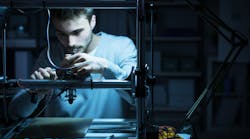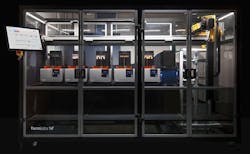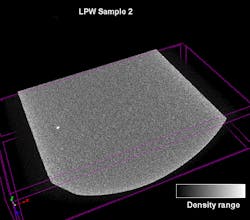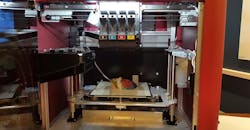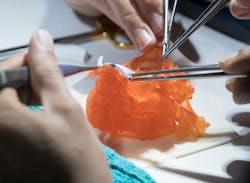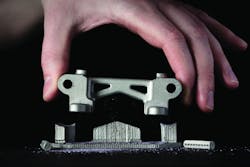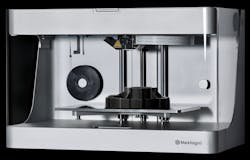Reducing cost, new processes, and greater research are key drivers that will grow the 3D printing, or additive manufacturing, market in 2018. This will be largely due to price reductions increasing the access and availability of the technology to a broader audience. However, increasing automation, expanding materials, voxel control, and improving software will all play a role as well. Here are some of the points and drivers of 2017 that will become more prevalent in 2018 and some new tech that will continue to push the limits of 3D printing.
Reducing cost is opening 3D printing to small and medium sized companies that is growing the industry. However, high-profile partnership announcements from BASF, BMW, Airbus, and Rolls-Royce will form a large part of the market. Mergers and acquisitions will create power houses in this industry. For example, PyroGenesis in Canada signing an NDA with Rolls-Royce; LPW Technology and Airbus APWORKS partnering; and BMW selecting 3D Systems as their partner of choice for AM.
M&A in AM
Mergers and acquisition will play a large role in the future of additive manufacturing. Specifically, acquiring companies to secure a supply chain will be increasingly important. Collaboration and/or mergers to control powder metals will indicate which company will excel in the 3D printing market. As demand rises for 3D printing, whoever corners the supply chain will lead the market.
While these partnerships will make it harder for small and medium-sized businesses, the ones acquired will be elevated to new possibilities. This will streamline the process, from material to finished product, making it more cost-effective and faster. This will lead to new levels of automation, from ordering to production.
Automation
Automation will drive down cost and increase speeds by reducing labor, and allowing 24/7 operation.
Robot cells were seen throughout 2017, and will become more typical in 2018. Formlabs released Form Cell, Stratasys and Desktop Metal have the Demonstrator, and 3D Systems launched Figure 4. These are automated cells that can print continuously, eliminating the labor involved in pulling out parts, replacing the build tray, and starting a new print. Voodoo Manufacturing employed a Universal Robot to help increase its automation, and the company tripled its output. Using the UR10, a collaborative robot, with a two-finger gripper kit from Robotiq, brought a six-month ROI.
The Form Cell uses software to reduce support materials. this can save material and increase print time.
In addition, automation is increasing the amount of parts needed to compete with traditional processes. “In the past, we would typically switch from 3D printing to injection molding when an order hit 300 to 400 parts. With the Continuous Build 3D Demonstrator, that number goes way up to around 1,500 to 2,000 parts,” says Rich Stump, principal and co-founder of FATHOM. “The Demonstrator allows customers to reap the time and cost benefits of repeatable and constant 3D printing. Along with the advantages of an iterative design process and reducing complexity, the Demonstrator makes AM a serious contender pricewise with injection molding for low-volume and bridge-to-production runs.”
The Stratasys Demonstrator helps increase print capacity for 3D printers. Each printer is able to communicate in real time. This machine doesn’t have to stop between parts or between jobs. The FDM also eliminates some processes, like curing, which is needed for SLA parts.
Automation doesn’t start in the printer. Protolabs, Stratasys, 3D Systems, and Xometry all offer some type of 3D printing quote online. Even smaller companies such as Voodoo Manufacturing, Fathom, GoProto, and 3Dhubs.com are adopting automated quoting.
With automated quoting and continuous printing, it may be possible for a designer to upload a file, and have no human involvement until perhaps post-processing, packaging, or shipping. The technology exists, but hasn’t been executed. This will greatly increase the importance of software, but while possible, it’s not the best idea. Having a human eye somewhere in the process will be important for customer satisfaction and to fix mistakes before a part goes too far in the process.
In-Line Inspection
Being able to inspect every part for error while it is being manufactured would be too costly. However, Sigma Labs, a software company, is helping to assure the quality of metal AM parts. The company started with some related work when Boeing was developing its 787 Dreamliner. Boeing was looking for quality-assurance software to effectively get rid of the inspector. “Having a digital thread that follows a design from concept to finish gives the regulating bodies (in aerospace, it’s the FAA) objective evidence of compliance,” says Mark Cola, CEO of Sigma Labs. “Quality-assurance software can track a process and part to verify that as long as everything documented in the digital thread was within a specific window, or parameter, that part can be certified.”
Here is the output from a CT scan of titanium alloy powder. The sample is relatively small, but contains over 100,000 individual particles. The white spot in the left of the image shows an inclusion. This may be a small spot, but even a small contamination can start crack propagation, and lead to failure.
This is only able to be done through the understanding of the entire process: thermal history, microstructure, the mechanical properties affecting end-product performance. This means a lot of trial and error in the laboratories during process window development for production to follow. Measurements during development increase the accuracy of quality software for use in production. To obtain data without interfering with production, Sigma Labs uses non-contact thermal sensors to track the melt (weld) pool and the part temperatures during the print. This data, with previously tested research, helps verify the properties of the finished product without a separate inspection step.
Even today, research conducted at the U.S. Department of Energy’s (DOE’s) Advanced Photon Source (APS) at Argonne National Laboratory in Illinois is revealing for the first time how microscopic defects arise during the production of 3D-printed metals. The research harnesses the power of the APS, the nation’s leading source of hard (short-wavelength) X-rays, to image the AM process. Research like this will offer data for more accurate in-line inspections that, in turn, will drive the AM market through improved reliability.
Voxel Control
While inspecting every inch of a part is important, being able to control the properties of those areas is something many companies are working on. A voxel is like a pixel in a photo, but in three dimensions. Like a stress element, imagine a part made of tiny cubes. Each cube would be a voxel. Many companies are trying to control each individual cube to allow a change in color, durometers, and other properties that will continue to be a trend in 2018.
Controlling each voxel property, such as conductivity, thermo-insulating, and thermo-conducting inks can create active smart sensors in order to have a 3D-printed part that actually has active materials in it. You can even create a battery within a 3D-printed structure.
Today, XYZ Printing’s da Vinci Color and Mcor print in color. Mcor has been around for years, but only builds in layers of paper in a lamination process. The da Vinci Color uses the fused filament fabrication (FFF) or extruded plastic process. Generally, both are what would happen if you added a 2D color printer to a 3D printer.
The new da Vinci Color is able to produce 16 million shades of colors, and has speed around 30 to 60 mm/sec.
Next year Hewlett-Packard is planning on gaining further voxel control with color, too. “In 2018, we [HP] intend to bring full color to the 3D printing lineup. Color is a great example of building at the voxel level… We plan to combine this color capability with a new lower-price position,” says HP’s 3D printing business president, Stephen Nigro.
Going a step further, Stratasys is known for its Polyjet, a multi-jetting process that is able to alter colors and the durometer, or rigidity, in a part. Recently, a new software solution for the J750 combines the power of multi-material 3D printing with microscopic voxel-level control, enabling users to create advanced structures, gradient color patterns, internal properties, and textures to fit precise material requirements.
For example, many of the world’s hearing aids today are 3D-printed with stereolithography (SLA) technology, which limits the structure of the device to one material property. With multi-jetting, it is possible to 3D-print hearing aids with a rigid interior channel for sound to bounce through the hearing canal, while the exterior is coated in soft, flexible material for a comfortable fit. Applications like this will grow 3D printing in the medical field.
Unveiled at the Radiological Society of North America’s 2017 show, Stratasys unveiled 3D-printed anatomical structures including disease pathology that mimic the look and feel of biological parts to accelerate guidance, testing, and education. Engineered in conjunction with top researchers and manufacturers, service initially includes fully functional bone and heart models, with vascular structures expected in early 2018. This technology will eliminate restrictions associated with research on animal, mannequin, or cadaver models—BioMimics effectively mirrors intricacies of both soft tissue and hard bones via multi-material 3D printing.
Surgical trainees practice on 3D printed heart with congenital defect leveraging BioMimics.
A paper published by Nature Biotechnology talks about how “3D bioprinting is being applied to regenerative medicine to address the need for tissues and organs suitable for transplantation. Compared with non-biological printing, 3D bioprinting involves additional complexities, such as the choice of materials, cell types, growth and differentiation factors, and technical challenges related to the sensitivities of living cells and the construction of tissues. Addressing these complexities requires the integration of technologies from the fields of engineering, biomaterials science, cell biology, physics and medicine. 3D bioprinting has already been used for the generation and transplantation of several tissues, including multilayered skin, bone, vascular grafts, tracheal splints, heart tissue and cartilaginous structures. Other applications include developing high-throughput 3D-bioprinted tissue models for research, drug discovery and toxicology.” This technology will also grow and has the potential to be a multibillion-dollar market, but it will move slower than other 3D printing markets due to regulations.
Metal
Regulations haven’t seemed to slow metal printing. Whether for medical devices, or manufacturing parts for planes, trains, or automobiles, metal 3D printing is expected to grow continuously through 2018. A report from IDTechEx notes, “In 2017, several companies launched new printer technologies with the promise of overcoming some of the existing barriers to adoption, such as lower printer prices, faster build speeds, cheaper materials, and more. Increasing throughput and streamlining production efficiencies will drive demand growth for printers and materials substantially. Given these market trends, IDTechEx forecasts the global market for 3D printing metals will reach a value of $12 billion by the year 2028.” This was taken from Today’s market to 2028.
In 2017 Desktop Metal Production System launched its metal 3D printer. This speeds up the powder-bed process with two powder spreaders so each pass adds a layer to the parts being printed. The spreader is followed by a binder agent that is jetted on much like a traditional 2D printer. In addition, there is an anti-sintering agent that is dropped to help support structures to fall off to save time in post processing.
The new Desktop Metal metal 3D printer uses powder metallurgy to print quickly, and sinter parts in one step. In one example an impeller was printed using a laser-based printer and the new Desktop Metal. In the time it took the laser based printer to produce 12 parts, Desktop Metal made over 500.
This printer produces a powder metallurgy (PM) part that will then be heated to remove the binder agent and to gain full density. Following the automation trend, the heating is done in the same machine. Parts go to the user’s CAD program to a fully dense PM part with only some labor in post processing to complete a build.
Hewlett-Packard has seen the metal 3D printing market and invested heavily. Nigro, the company’s 3D printing business president, mentioned aspiration to disrupt the $12 trillion manufacturing market. “Now, we are expanding beyond plastic to metals. But why now? Pretty much the same reason we got into 3D plastics with Multi Jet Fusion. … We have developed a novel 3D metal approach that is built around a combination of high quality and improving the economics of 3D printed metals.” Without going into details about the process, Nigro mentioned that HP is looking to bring about high-volume metal printing at an affordable rate in 2018.
The price of 3D printing metal systems has been reduced from hundreds of thousands of dollars, or even millions, to just over $100,000 to get started. This cost reduction would also mean the price per part could be reduced while maintaining the same ROI. In addition, breakthroughs like this increase access and reduce the barrier to entry for small to medium businesses to this technology.
The new Markforged carbon fiber printer is able to produce load-bearing parts that require high strength. In some examples, it is possible to print parts faster and cheaper than machining metal.
Overall, the development of new processes that will expand the designer’s palette of materials will be successful. Sometimes a metal is used simply because an application demands high strength, but some high-strength polymers have been expanding their use. In 2017 we saw Markforged launch Mark Two, focusing on plastic, metal, and carbon fiber printing.
Markforged is already finding its way into automotive, healthcare, aerospace, and government and defense. The carbon fiber parts in general are up to 20 times stiffer than ABS plastic, five times stronger, and have a higher strength-to-weight ratio than 6061-T6 aluminum, letting designers 3D-print functional parts that would otherwise need to be CNC-machined.
3D printing for 2018 will continue with more of the same improvements as 2017: cost reduction, new features, and materials. Cost will be driven by M&A and ability to automate. Features and materials will help grab attention and market share that will continue to expand the market horizontally while finding new verticals. These will be features such as voxel control and the ability to use multiple materials.
Metals and new high-strength polymers will continue to be in high demand for 2018. Any company that streamlines the supply chain will see great success. Finally, the software will always be imperative to development. Making printers user-friendly, finding way to reduce support materials, finding errors in CAD models before printing, and suggesting design changes for more efficient printing will give savvy players a leg up in the additive manufacturing industry.
